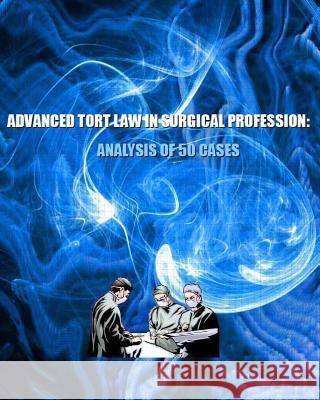Advanced Tort Law in Surgical Profession: Analysis of 50 Cases » książka
Advanced Tort Law in Surgical Profession: Analysis of 50 Cases
ISBN-13: 9781492874607 / Angielski / Miękka / 2013 / 292 str.
Unconscious null-para arrives in emergency room with the uterine rupture in progress. A cesarean section is performed followed by hysterectomy. Understandably, the surgery causes a permanent impairment. Result? No battery. Why? The hospital and physicians can prove an affirmative defense of consent. In a prima facie case, for a patient incapable of giving or withholding consent, the consent is implied by law. So too, there was no intent to harm the patient. What about negligence? There is a room for the negligence claim in this case, because the hospital and physicians had the duty to perform a procedure with careful considerations of per quod determinants, burden/benefit ratio, including the wishes of the patient to remain fecund or fertile. To establish a negligence and to build a case, the informed consent doctrine is irrelevant, for this case addresses all six elements of medical negligence: duty, applicable standard of care, breach, actual cause, proximate case, and damage. The law of surgical negligence is an ever-evolving overhaul of acts, codes, stare, decisis, or doctrines. Any definition in surgical malpractice that includes the notion of reasonableness raises alarm bells. The action for surgical negligence may extend from misdiagnoses, wrong site surgery, misrepresentation, to injurious falsehood, investment privilege, joint ownership, patent infringement, culpability, or defamation. Packed in 27 chapters and 29 illustrations of surgical scenes, the current effort briefs 50 published cases of surgical negligence, from I.R.A.C. (issue, rule, analysis, conclusion), precedents, legal limits, to dispositions, verdicts, remedies, and reasoning pursuant to the Constitutional or statute enactments in the United States and District of Columbia. The presented cases are sourced at LexisNexis, (TM) BlueBook, and Westlaw. All cases are published, and free for the public visit under the U.S. Health Insurance Portability & Accountability Act (HIPAA), the Brady Rule, the Patient Safety & Quality Improvement Act 2005 (PSQIA), 14th Amendment Due Process Clause, 17 U.S.C. 512, Digital Millennium Copyright Act (DMCA); among other instruments. Each case analysis ends with keywords.
Zawartość książki może nie spełniać oczekiwań – reklamacje nie obejmują treści, która mogła nie być redakcyjnie ani merytorycznie opracowana.











